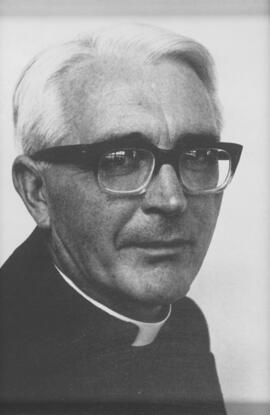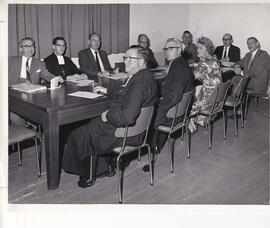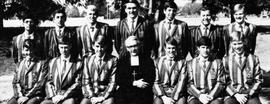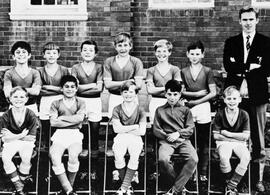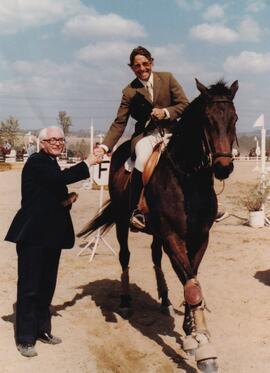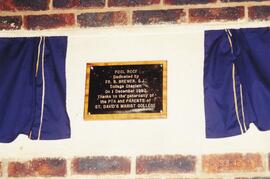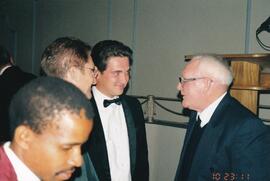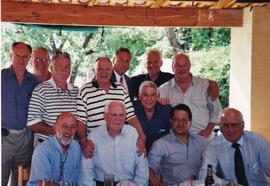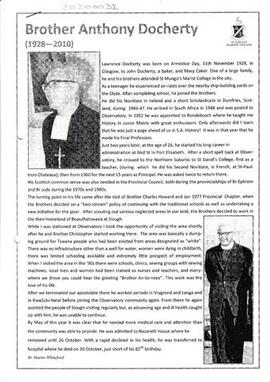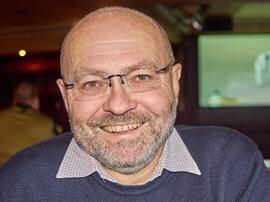Interview with Brother Anthony 1957 – 1975, 1982
When he first came to St David’s, Brother Anthony was in charge of the senior boarders
in the boarding school. He recalls that the boys used to go to the Jukskei River and have
mud fights over the weekends.In those days the Maristonian club was on the main road
to Pretoria.
Brother Anthony was particularly proud of the development of sports facilities at the
school. The 45 acres (18 hectares) where the cricket oval, rugby fields, astro turf and
CEO’s house now stand were originally owned by a Scotsman, Mr McGill Love. The
gendtleman in question owned a company, Haggie Rand, which sold cables to the mines
and he gave the school fist option to purchase the land. In 1963 the school bought the
land for R150 000. The municipality then wanted some of the land to widen Rivonia
Road. Ronnie Walker was chairman of the school committee and Watson, the mayor (he
had a son at St David’s). The municipality paid R127,000 the land, 10% of the property
purchased. The money made was used for building the Science laboratories. ater,
McGregor, Dowson and Dobson leveled the fields for R14,000 and in 1966 the grass
was laid. McGregor’s son won 7 gold medals in the SA championships the cricket oval
was named after McGregor.
There was some debate whether there was enough space for a full cricket oval, and
indeed there was. Pete Springer a professional cricketer for England came together with
the Bishop Hugh Boyle to officially open the oval. Brother Anthony recalled that the
Bishop’s opening prayer was for chastity!! A party followed in the dining room which now
houses the college library.
The current CEO’s house, a Herbert Baker house was used at that time to
accommodate the professional cricketers – Dickey Bird, Dobson and for boarders
upstairs. The remainder was used for storage and for an office for the PTA. Don Wilson
saw a ghost of a woman at the top of the stairs. What was the A Dormitory is now used
for the grade 6 classrooms.
The first black child was admitted to the school in 1976, the son of the Malawian trade
commissioner.
Headmaster Murphy only lasted 6 months and Brother Anthony came to the rescue as
the new head was having difficulties in adjusting, there was no prep headmaster as Mr
Monolias had left to go to a school in Benoni after coming to St David’s from Bryanston
High School. Br Anthony checked out the rumours of Murphy’s wrestling career whilst he
was in Cape Town. Using the public library Br Anthony finally came across an article in
the Durban press relating to the wrestling. Br Anthony had to step into the breach and
was headmaster from 1981 – 2. He then escaped once more to the desert in Slough.
Outstanding boys that Br Anthony remembered were Roberto Amato , matric 1960. His
father was Rhodes scholar, he was a wonderful boy and was instrumental in starting up
a school band. The matric class of 1961 was a small class, a group of six boys, three
became surgeons and one a professor. B Haakman, Malcolm Fenzman, Nigel Sloane.
Prince Ipsolante who was related to Prince Phillip.
American field scholars used to come to St David’s as exchange students in the 70’s.
Br Anthony remembered another mother who was particularly angry with him and it
reminded him of being back in Glasgow watching a Celtic/Rangers match.
Fulton a US golfer was a former pupil.
One boy came to school with a gun and wanted to shoot a couple of the teachers
however, the next day Br Anthony managed to confiscate the gun and called the boys
father. It turned out that the gun belonged to the father and had been acquired during the
war from the RAF.
Another rather funny incident was when Br Anthony caught a boy coming out of the cold
room in the kitchen with a rather large stomach. He was hiding a watermelon under his
jersey!
In 1966 the first boy to become a drug addict was expelled after a debate with parents
on the issue.
There have been only three matrons in 70 years.
An amusing incident occurred when a teacher, Ms Janosch collapsed in the toilet, Br
Anthony went to her aid and managed to get her onto a carpeted area, whereupon she
grabbed his crucifix and pulled him down on top of her just as Br Andrew walked in!
There was a flourishing riding club with stables where the grade O block is now. Ken
Booth, the Queen’s chaplain was a keen rider and took teams of boys to the Hickstead
trials where they achieved first place in the second year of competing. Horses were on
the property and there was a riding club until 1980
There was a teacher named Zacharovitch, a former priest who Bro Anthony found
working in a local bottle store. Bro Anthony acquired the permission to employ him as a
teacher and he turned out to be a good one.
Br Anthony’s nickname was Oranges and Br Andrew – Drac. Br Irwin was the first head
after Br Wilson and only lasted 6 months – the auditorium was named after him.
Teachers – it was a priority that the school had to have good teachers but there will
always be those, a small percentage, who are no good.
The first board of governors included parents such as Moni, Herber and Paizes. School
fees were GBP4 per term in Bro Anthony’s time. They tried to keep the fees down but
the board of governors said that the fees needed to be adjusted. A proposition was
made to the regional council who gave the Ok to raise the fees. The local schools
followed suit. Subsequently there was a protest at the school gates and a Mr Emberton-
Smith and Mrs Hogg protested against the increase and handed out fliers.
Br Anthony coached rugby, there were 8 open teams and he preferred to teach the
weaker teams. He remembered the first time the school beat Jeppe (1000 pupils, St
David’s 238) the boys were enraged at being called Catholic Jews. There were quite a
number of Jewish pupils at the school during this time.
Br Anthony remembered two dogs, a female called Lola Brigida and a Doberman
Pincher called Dagwood. Dagwood was a very friendly dog who used his jaw to grab Br
Anthony by the hand but never bit him.
Brothers and Priests included Father Plestus, Br O’Brien who accidentally killed a
woman who ran out in front of him and was very upset also by the police comment “One
less” Br Anthony consoled him and gave him brandy but he was never the same after
that. They also had a Dominican priest for a while who had a nephew at the school.
The first chapel was next to the first classroom. Br Rowson, who was often “unwell”,
would light a candle to indicate his presence. Br Rowson only lasted 6 months.
The second chapel was in fact built as a library; the architect was Klench. The donation
for the current library was made by Mr Pinero now living overseas.
Vatican 11, 1967 was a significant and very disruptive time for all Catholics, there was
great upheaval in the church and many priests and nuns were looking for jobs. Some
priests were laicized and there was an exodus of brothers, Jesuits, Celesians etc. De La
Salle Brothers took in some of the priests.
Br Anthony remembered the school plays and one very good “Thomas More” in
conjunction with St Teresa’s. The schools didn’t have the numbers for big productions.
Musical evenings were held although there was no hall and the dining room, now the
high school library, was used. One production was held at the civic centre with Paddy
O’Byrne as MC.
There was a band competition which St David’s won and Peter Moni was the drum
major.
A big walk was held to raise funds for the blind, St Teresa’s Guild for the Blind with Br
Paul coming across for this fundraiser.
JLE April 4, 2009

